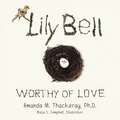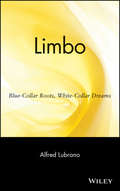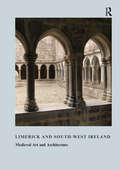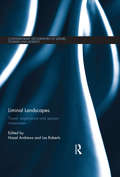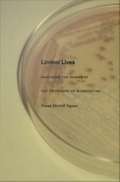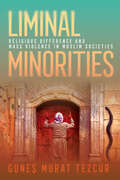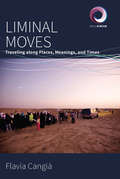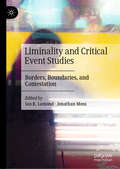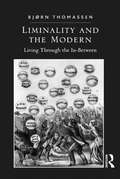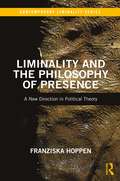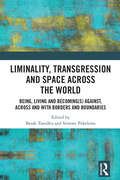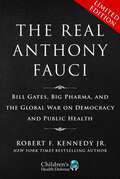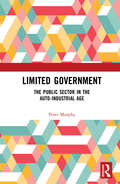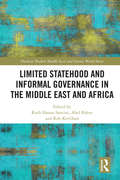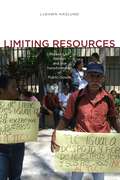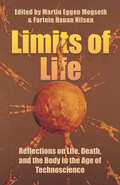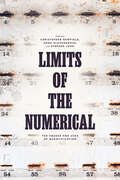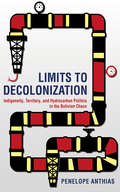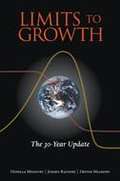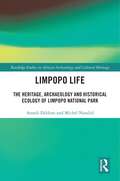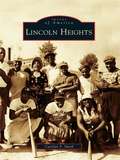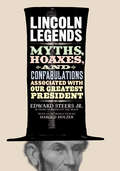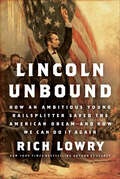- Table View
- List View
Lily Bell: Worthy of Love
by Amanda ThackerayLily Bell: Worthy of Love is timeless fable written for children yet touches the heart of all ages, especially those with special needs who long to be included. It is a story of a frail yet determined dove named Lily Bell who is unable to fly. With the help of her family and some unlikely friends, she journeys through the forest to finally find what she has been searching for: her purpose and worth. Lily Bell realizes that she can do all of the things with her friends, just in a different way.The moral of the story is we are all wonderfully made with a unique purpose and plan for our lives. Through our brokenness or “imperfections,” we are able to help others. With the “perfect” self-image being projected on to today’s generation, the story of Lily Bell: Worthy of Love is a heart-warming, uplifting, and relevant change that delivers a strong message of acceptance, friendship, and courage in a way that children will understand and adults will appreciate: we are all worthy of love.
Limbo: Blue-Collar Roots, White-Collar Dreams
by Alfred LubranoIn Limbo, award-winning journalist Alfred Lubrano identifies and describes an overlooked cultural phenomenon: the internal conflict within individuals raised in blue-collar homes, now living white-collar lives. These people often find that the values of the working class are not sufficient guidance to navigate the white-collar world, where unspoken rules reflect primarily upper-class values. Torn between the world they were raised in and the life they aspire too, they hover between worlds, not quite accepted in either. Himself the son of a Brooklyn bricklayer, Lubrano informs his account with personal experience and interviews with other professionals living in limbo. For millions of Americans, these stories will serve as familiar reminders of the struggles of achieving the American Dream.
Limerick and South-West Ireland: Medieval Art and Architecture (The\british Archaeological Association Conference Transactions Ser.)
by Roger StalleyThis book contains essays devoted to the medieval art and architecture of Limerick in the Munster province of South-West Ireland. It underpins the degree to which Irish craftsmen and builders engaged with the rest of Europe, and the nature of their relationship with English practice.
Liminal Landscapes: Travel, Experience and Spaces In-between (Contemporary Geographies of Leisure, Tourism and Mobility)
by Les Roberts Hazel AndrewsIdeas and concepts of liminality have long shaped debates around the uses and practices of space in constructions of identity, particularly in relation to different forms of travel such as tourism, migration and pilgrimage, and the social, cultural and experiential landscapes associated with these and other mobilities. The ritual, performative and embodied geographies of borderzones, non-places, transitional spaces, or ‘spaces in-between’ are often discussed in terms of the liminal, yet there have been few attempts to problematize the concept, or to rethink how ideas of the liminal might find critical resonance with contemporary developments in the study of place, space and mobility. Liminal Landscapes fills this void by bringing together variety of new and emerging methodological approaches of liminality from varying disciplines to explore new theoretical perspectives on mobility, space and socio-cultural experience. By doing so, it offers new insight into contemporary questions about technology, surveillance, power, the city, and post-industrial modernity within the context of tourism and mobility. The book draws on a wide range of disciplinary approaches, including social anthropology, cultural geography, film, media and cultural studies, art and visual culture, and tourism studies. It brings together recent research from scholars with international reputations in the fields of tourism, mobility, landscape and place, alongside the work of emergent scholars who are developing new insights and perspectives in this area. This timely intervention is the first collection to offer an interdisciplinary account of the intersection between liminality and landscape in terms of space, place and identity. It therefore charts new directions in the study of liminal spaces and mobility practices and will be valuable reading for range of students, researchers and academics interested in this field.
Liminal Lives: Imagining the Human at the Frontiers of Biomedicine
by Susan Merrill SquierEmbryo adoptions, stem cells capable of transforming into any cell in the human body, intra- and inter-species organ transplantation--these and other biomedical advances have unsettled ideas of what it means to be human, of when life begins and ends. In the first study to consider the cultural impact of the medical transformation of the entire human life span, Susan Merrill Squier argues that fiction--particularly science fiction--serves as a space where worries about ethically and socially charged scientific procedures are worked through. Indeed, she demonstrates that in many instances fiction has anticipated and paved the way for far-reaching biomedical changes. Squier uses the anthropological concept of liminality--the state of being on the threshold of change, no longer one thing yet not quite another--to explore how, from the early twentieth century forward, fiction and science together have altered not only the concept of the human being but the contours of human life. Drawing on archival materials of twentieth-century biology; little-known works of fiction and science fiction; and twentieth- and twenty-first century U. S. and U. K. government reports by the National Institutes of Health, the Parliamentary Advisory Group on the Ethics of Xenotransplantation, and the President's Council on Bioethics, she examines a number of biomedical changes as each was portrayed by scientists, social scientists, and authors of fiction and poetry. Among the scientific developments she considers are the cultured cell, the hybrid embryo, the engineered intrauterine fetus, the child treated with human growth hormone, the process of organ transplantation, and the elderly person rejuvenated by hormone replacement therapy or other artificial means. Squier shows that in the midst of new phenomena such as these, literature helps us imagine new ways of living. It allows us to reflect on the possibilities and perils of our liminal lives.
Liminal Minorities: Religious Difference and Mass Violence in Muslim Societies (Religion and Conflict)
by Günes Murat TezcürLiminal Minorities addresses the question of why some religious minorities provoke the ire of majoritarian groups and become targets of organized violence, even though they lack significant power and pose no political threat. Güneş Murat Tezcür argues that these faith groups are stigmatized across generations, as they lack theological recognition and social acceptance from the dominant religious group. Religious justifications of violence have a strong mobilization power when directed against liminal minorities, which makes these groups particularly vulnerable to mass violence during periods of political change.Offering the first comparative-historical study of mass atrocities against religious minorities in Muslim societies, Tezcür focuses on two case studies—the Islamic State's genocidal attacks against the Yezidis in northern Iraq in the 2010s and massacres of Alevis in Turkey in the 1970s and 1990s—while also addressing discrimination and violence against followers of the Bahá'í faith in Iran and Ahmadis in Pakistan and Indonesia. Analyzing a variety of original sources, including interviews with survivors and court documents, Tezcür reveals how religious stigmatization and political resentment motivate ordinary people to participate in mass atrocities.
Liminal Moves: Traveling along Places, Meanings, and Times (Worlds in Motion #9)
by Flavia CangiàMoving, slowing down, or watching others moving allows people to cross physical, symbolic, and temporal boundaries. Exploring the imaginative power of liminality that makes this possible, Liminal Moves looks at the (im)mobilities of three groups of people - street monkey performers in Japan, adolescents writing about migrants in Italy, and men accompanying their partners in Switzerland for work. The book explores how, for these ‘travelers’, the interplay of mobility and immobility creates a ‘liminal hotspot’: a condition of suspension and ambivalence as they find themselves caught between places, meanings and times.
Liminality and Critical Event Studies: Borders, Boundaries, and Contestation
by Ian R. Lamond Jonathan MossThis book explores and challenges the concept and experience of liminality as applied to critical perspectives in the study of events. It will be of interest to researchers in event studies, social and discursive psychology, cultural and political sociology, and social movement studies. In addition, it will provide interested general readers with new ways of thinking and reflecting on events. Contributing authors undertake a discussion of the borders, boundaries, and areas of contestation between the established social anthropological concept of liminality and the emerging field of critical event studies. By drawing these two perspectives closer together, the collection considers tensions and resonances between them, and uses those connections to enhance our understanding of both cultural and sporting events and offer fresh insight into events of activism, protest, and dissent.
Liminality and the Modern: Living Through the In-Between
by Bjørn ThomassenThis book provides the history and genealogy of an increasingly important subject: liminality. Coming to the fore in recent years in social and political theory and extending beyond is original use as developed within anthropology, liminality has come to denote spaces and moments in which the taken-for-granted order of the world ceases to exist and novel forms emerge, often in unpredictable ways. Liminality and the Modern offers a comprehensive introduction to this concept, discussing its development and laying out a conceptual and experiential framework for thinking about change in terms of liminality. Applying this framework to questions surrounding the implosion of ’non-spaces’, the analysis of major historical periods and the study of political revolution, the book also explores its possible uses in social science research and its implications for our understanding of the uncertainty and contingency of the liquid structures of modern society. Shedding new light on a concept central to social thought, as well as its capacity for pushing social and political theory in new directions, this book will be of interest to scholars across the social sciences and philosophy working in fields such as social, political and anthropological theory, cultural studies, social and cultural geography, and historical anthropology and sociology.
Liminality and the Philosophy of Presence: A New Direction in Political Theory (Contemporary Liminality)
by Franziska HoppenThis book departs from the attempt by political theory to confront the challenges of political life with new concepts, offering instead a mode of thought so far excluded from the canon of political theory: the philosophy of presence. Making the experience of liminality the very centre of thought, it shows how embracing ‘in-betweenness’ allows us to discern the limits of both the political order and contemporary political theory. Through an examination of the works of Gustav Landauer, Eric Voegelin, Simone Weil and Václav Havel, the author demonstrates the manner in which ‘in-betweenness’ may be cultivated by way of the philosophy of presence as a method of self-enquiry into existence as it is experienced subjectively. Arguing that since externalisation is the essence of politics and that the way to a more just society lies inwards, through a confrontation with liminality, this study of how to read philosophers of presence renders their work intelligible to the contemporary discourse of crisis and will appeal to scholars of social, political and anthropological theory and philosophy.
Liminality, Transgression and Space Across the World: Being, Living and Becoming(s) Against, Across and with Borders and Boundaries
by Basak Tanulku Simone PekelsmaThis book analyses various forms of liminality and transgression in different geographies and demonstrates how and why various physical and symbolic boundaries create liminality and transgression.Its focus is on comprehending the ways in which these borders and boundaries generate liminality and transgression rather than viewing them solely as issues. It provides case studies from the past and present, allowing readers to connect subjects, periods, and geographies. It consists of theoretical and empirical chapters that demonstrate how borders and liminality are interconnected. The book also benefits from the power of several visual essays by artists to complete the theoretical and empirical chapters which demonstrate different forms of liminality without need of much words.The book will be of interest to researchers and students working in the fields of urban and rural studies, urban sociology, cities and communities, urban and regional planning, urban anthropology, political science, migration studies, human geography, cultural geography, urban anthropology, and visual arts.
Limited Boxed Set: Bill Gates, Big Pharma, and the Global War on Democracy and Public Health (Children’s Health Defense)
by Robert F. Kennedy Jr.#1 on AMAZON, and a NEW YORK TIMES, WALL STREET JOURNAL, USA TODAY and PUBLISHERS WEEKLY NATIONAL BESTSELLERPharma-funded mainstream media has convinced millions of Americans that Dr. Anthony Fauci is a hero. He is anything but.As director of the National Institute of Allergy and Infectious Diseases (NIAID), Dr. Anthony Fauci dispenses $6.1 billion in annual taxpayer-provided funding for scientific research, allowing him to dictate the subject, content, and outcome of scientific health research across the globe. Fauci uses the financial clout at his disposal to wield extraordinary influence over hospitals, universities, journals, and thousands of influential doctors and scientists—whose careers and institutions he has the power to ruin, advance, or reward. During more than a year of painstaking and meticulous research, Robert F. Kennedy Jr. unearthed a shocking story that obliterates media spin on Dr. Fauci . . . and that will alarm every American—Democrat or Republican—who cares about democracy, our Constitution, and the future of our children&’s health. The Real Anthony Fauci reveals how &“America&’s Doctor&” launched his career during the early AIDS crisis by partnering with pharmaceutical companies to sabotage safe and effective off-patent therapeutic treatments for AIDS. Fauci orchestrated fraudulent studies, and then pressured US Food and Drug Administration (FDA) regulators into approving a deadly chemotherapy treatment he had good reason to know was worthless against AIDS. Fauci repeatedly violated federal laws to allow his Pharma partners to use impoverished and dark-skinned children as lab rats in deadly experiments with toxic AIDS and cancer chemotherapies. In early 2000, Fauci shook hands with Bill Gates in the library of Gates&’ $147 million Seattle mansion, cementing a partnership that would aim to control an increasingly profitable $60 billion global vaccine enterprise with unlimited growth potential. Through funding leverage and carefully cultivated personal relationships with heads of state and leading media and social media institutions, the Pharma-Fauci-Gates alliance exercises dominion over global health policy. The Real Anthony Fauci details how Fauci, Gates, and their cohorts use their control of media outlets, scientific journals, key government and quasi-governmental agencies, global intelligence agencies, and influential scientists and physicians to flood the public with fearful propaganda about COVID-19 virulence and pathogenesis, and to muzzle debate and ruthlessly censor dissent.
Limited Government: The Public Sector in the Auto-Industrial Age
by Peter MurphyThis book explores why, despite increased government spending on income-support, health and education, the costs of public goods are rising and their quality is declining. Charting the rise of big government, the author identifies a growing divergence between public-sector ideals and the realities of troubled political economies grappling with debt, deficits, ageing populations, improvident social insurance, declining education test scores and multiplying health costs. Limited Government analyzes in detail the social and political factors in major economies that drive up public spending, as well as the relationship between spending and outcomes. By developing an alternate model of public finances, and engaging in a critique of the managerial society, the author emphasizes the positive effects of self-management, social self-organization and technological automation, arguing that high-quality, low-cost goods are the result of nations that save, not states that tax. A sociological account of public finances, Limited Government outlines how governments can spend less and yet help ensure good broad equitable standards of health, education and income security.
Limited Statehood and Informal Governance in the Middle East and Africa (Durham Modern Middle East and Islamic World Series)
by Ruth Hanau Santini Abel Polese Rob KevlihanHybrid forms of governance – where the central state authority does not possess a monopoly of violence and fails to exercise control – are not only an epiphenomena, but a reality likely to persist. This book explores this phenomenon drawing on examples from the Middle East and Africa. It considers the different sorts of actors – state and non-state, public and private, national and transnational – which possess power, examines the dynamics of the relationships between central authorities and other actors, and reviews the varying outcomes. The book provides an alternative view of the way in which governance has been constructed and lived, puts forward a conceptualisation of various forms of governance which have hitherto been regarded as exceptions, and argues for such forms of governance to be regarded as part of the norm.
Limiting Resources: Market-Led Reform and the Transformation of Public Goods (G - Reference, Information and Interdisciplinary Subjects)
by LaDawn HaglundThe provision of public goods such as education, electricity, health, sanitation, and water used to be regarded as primarily the responsibility of governments, but in the 1980s privatization of such services spread and reliance on market mechanisms instead of governments became common in many parts of the world, including developing countries. The record of the past twenty-five years of market-led development, however, has not been encouraging. Not only has it failed to improve public services significantly, but it has also undermined democratic institutions and processes, reproduced authoritarian relations of power, and suppressed alternatives made possible by an increasing global acceptance of the importance of economic and social rights. In Limiting Resources, LaDawn Haglund seeks an understanding of public goods that can better serve the needs of people in developing countries today.Haglund critiques the narrow conception of public goods used in economics, which tends to limit the range of resources considered “public,” and proposes an expanded conception drawing from multiple disciplines that incorporates issues of justice, inclusion, and sustainability. She then uses case studies of electricity and water provision in Central America to illuminate the conditions for success and the causes of failure in constructing adequate mechanisms for the supply of public goods. She follows with an analysis of political conflicts over privatization that reveals how neoliberal policies have made effective state action difficult. The book concludes with suggestions for ways in which this reformulated conception of public goods can be applied to promote justice, sustainability, and economic and social rights in developing countries.
Limits of Life: Reflections on Life, Death, and the Body in the Age of Technoscience
by Martin Eggen Mogseth & Fartein Hauan NilsenNew technologies and scientific imagination rearrange the boundary that we identify as the beginning and end of life. New techno-social constellations, such as the ever-increasing presence of digital avatars and genetic screenings, implore us to reconsider and transcend the existing definitions of life and death. Through a multidisciplinary approach, this volume explores how the limitations and perceived finality of life and death are reconstituted through engagements with modern technology.
Limits of the Numerical: The Abuses and Uses of Quantification
by Christopher Newfield Stephen John Anna AlexandrovaThis collection examines the uses of quantification in climate science, higher education, and health. Numbers are both controlling and fragile. They drive public policy, figuring into everything from college rankings to vaccine efficacy rates. At the same time, they are frequent objects of obfuscation, manipulation, or outright denial. This timely collection by a diverse group of humanists and social scientists challenges undue reverence or skepticism toward quantification and offers new ideas about how to harmonize quantitative with qualitative forms of knowledge. Limits of the Numerical focuses on quantification in several contexts: climate change; university teaching and research; and health, medicine, and well-being more broadly. This volume shows the many ways that qualitative and quantitative approaches can productively interact—how the limits of the numerical can be overcome through equitable partnerships with historical, institutional, and philosophical analysis. The authors show that we can use numbers to hold the powerful to account, but only when those numbers are themselves democratically accountable.
Limits of the Numerical: The Abuses and Uses of Quantification
by Christopher Newfield Stephen John Anna AlexandrovaThis collection examines the uses of quantification in climate science, higher education, and health. Numbers are both controlling and fragile. They drive public policy, figuring into everything from college rankings to vaccine efficacy rates. At the same time, they are frequent objects of obfuscation, manipulation, or outright denial. This timely collection by a diverse group of humanists and social scientists challenges undue reverence or skepticism toward quantification and offers new ideas about how to harmonize quantitative with qualitative forms of knowledge. Limits of the Numerical focuses on quantification in several contexts: climate change; university teaching and research; and health, medicine, and well-being more broadly. This volume shows the many ways that qualitative and quantitative approaches can productively interact—how the limits of the numerical can be overcome through equitable partnerships with historical, institutional, and philosophical analysis. The authors show that we can use numbers to hold the powerful to account, but only when those numbers are themselves democratically accountable.
Limits of the Numerical: The Abuses and Uses of Quantification
by Christopher Newfield Stephen John Anna AlexandrovaThis collection examines the uses of quantification in climate science, higher education, and health. Numbers are both controlling and fragile. They drive public policy, figuring into everything from college rankings to vaccine efficacy rates. At the same time, they are frequent objects of obfuscation, manipulation, or outright denial. This timely collection by a diverse group of humanists and social scientists challenges undue reverence or skepticism toward quantification and offers new ideas about how to harmonize quantitative with qualitative forms of knowledge. Limits of the Numerical focuses on quantification in several contexts: climate change; university teaching and research; and health, medicine, and well-being more broadly. This volume shows the many ways that qualitative and quantitative approaches can productively interact—how the limits of the numerical can be overcome through equitable partnerships with historical, institutional, and philosophical analysis. The authors show that we can use numbers to hold the powerful to account, but only when those numbers are themselves democratically accountable.
Limits to Decolonization: Indigeneity, Territory, and Hydrocarbon Politics in the Bolivian Chaco (Cornell Series on Land: New Perspectives on Territory, Development, and Environment)
by Penelope AnthiasPenelope Anthias’s Limits to Decolonization addresses one of the most important issues in contemporary indigenous politics: struggles for territory. Based on the experience of thirty-six Guaraní communities in the Bolivian Chaco, Anthias reveals how two decades of indigenous mapping and land titling have failed to reverse a historical trajectory of indigenous dispossession in the Bolivian lowlands. Through an ethnographic account of the "limits" the Guaraní have encountered over the course of their territorial claim—from state boundaries to landowner opposition to hydrocarbon development—Anthias raises critical questions about the role of maps and land titles in indigenous struggles for self-determination.Anthias argues that these unresolved territorial claims are shaping the contours of an era of "post-neoliberal" politics in Bolivia. Limits to Decolonization reveals the surprising ways in which indigenous peoples are reframing their territorial projects in the context of this hydrocarbon state and drawing on their experiences of the limits of state recognition. The tensions of Bolivia’s "process of change" are revealed, as Limits to Decolonization rethinks current debates on cultural rights, resource politics, and Latin American leftist states. In sum, Anthias reveals the creative and pragmatic ways in which indigenous peoples contest and work within the limits of postcolonial rule in pursuit of their own visions of territorial autonomy.
Limits to Growth: The 30-Year Update
by Jorgen Randers Dennis Meadows Donella MeadowsJust over 30 years ago a path-breaking book was published called "The Limits to Growth." It posited the then controversial idea that unlimited growth on a finite planet would inevitably lead to ecological collapse. The book was translated into more than a dozen languages. Now "Limits to Growth: The 30 year Update" takes the analysis into the first decade of the 21st century to show that while the situation remains precarious, there is still time to bring the Earth back from the brink of ecological collapse.
Limpopo Life: The Heritage, Archaeology and Historical Ecology of Limpopo National Park (Routledge Studies in African Archaeology and Cultural Heritage)
by Anneli Ekblom Michel NotelidLimpopo Life introduces the reader to the material culture, oral histories, and the negotiation of conservation and landscape in an area now known as Limpopo National Park.Introducing the archaeology of a region that has not been surveyed or discussed, this book connects to the archaeology, history, heritage and conservation discussions in the southern African region as a whole. Vegetation history and paleoecology are combined with archaeological surveys and excavations, written sources, oral histories and travelogues to draw a picture of the diverse landscape of the Limpopo region. Intermixed within this narrative are sections that focus on an individual species, a life history, or an event providing a view of the complex and dynamic interactions. The role of humans in this diverse environment and how they have co-evolved with other species, shaping each other's destinies in a consequential and accidental way, is outlined.This book will be of interest to researchers and students interested in the archaeology, heritage and conservation of Mozambique, Zimbabwe and northern South Africa. It will also be of relevance to readers interested in the social history of the Limpopo and Kruger National Parks and this cross-border area.
Lincoln Heights (Images of America)
by Carolyn F. SmithLocated north of Cincinnati in the Mill Creek Valley, Lincoln Heights was the first African American self-governing community north of the Mason-Dixon Line. The development of Lincoln Heights began in 1923 when the Haley-Livingston Land Company of Chicago sold lots to black families in an unincorporated area called the Cincinnati Industrial Subdivision, now the southern section of Lincoln Heights. Water and sewerage were provided by special assessment through the Works Progress Administration, there were no building and zoning code services, fire and police protection were virtually nonexistent, and street maintenance and lighting were extremely inadequate. In 1939, residents of the area began efforts to incorporate so they could provide safety and necessary services for their growing community. Several of the original petitioners for incorporation lived in the Valley View subdivision, which later became the Wright Aeronautical plant, where many black migrants from the South came to help manufacture the famous B-29 bomber.
Lincoln Legends: Myths, Hoaxes, and Confabulations Associated with Our Greatest President
by Edward Steers Jr.&“Succinctly and eloquently debunks 14 popular myths about the Great Emancipator's life and death [with] solid documentation.&” —Publishers Weekly In the more than 150 years since his death, Abraham Lincoln has become America&’s most revered president. The mythmaking about this self-made man began early, some of it starting during his campaign for the presidency in 1860. As an American icon, Lincoln has been the subject of speculation and inquiry as authors and researchers have examined every aspect― personal and professional ―of the president&’s life. In Lincoln Legends, noted historian and Lincoln expert Edward Steers Jr. carefully scrutinizes some of the most notorious tall tales and distorted ideas about America&’s sixteenth president. Did he write his greatest speech on the back of an envelope on the way to Gettysburg? Did he appear before a congressional committee to defend his wife against charges of treason? Was he an illegitimate child? Did he have romantic encounters with women other than his wife—or love affairs with men? What really happened in the weeks leading up to April 14, 1865, and in the aftermath of Lincoln;s tragic assassination? Lincoln Legends evaluates the evidence on all sides of the many heated debates about the Great Emancipator, and also traces the often fascinating evolution of flawed theories about Lincoln and the motivations of the individuals―occasionally sincere but more often cynical, self-serving, and nefarious―who are responsible for their dispersal. Based on extensive primary research, Lincoln Legends will settle many of the enduring questions and persistent myths about Lincoln&’s life once and for all. &“Fascinating reading.&” —Tucson Citizen
Lincoln Unbound: How an Ambitious Young Railsplitter Saved the American Dream---And How We Can Do It Again
by Rich LowryIn this thoughtful mix of history and politics, the New York Times bestselling author and editor of National Review—the conservative bible founded by William F. Buckley, Jr.—traces Abraham Lincoln's ambitious climb from provincial upstart to political powerhouse and calls for a renewal of the Lincoln ethic of relentless striving.Revered today across the political spectrum, Abraham Lincoln believed in a small but active government in a nation defined by aspiration. Fired by an indomitable ambition from a young age, the man who would be immortalized as the "railsplitter" never wanted to earn his living with an ax. He educated himself in a frontier environment characterized by mind-numbing labor and then turned his back on that world. All his life, he preached a gospel of work and discipline toward the all-important ends of self-improvement and individual advancement. As a Whig and then a Republican, he worked to smash the rural backwardness in which he was raised and the Southern plantation economy that depended on human bondage.Both were unacceptably stultifying of human potential. In short, Lincoln lived the American Dream and succeeded in opening a way to it for others. He saw in the nation's founding documents the unchanging foundation of an endlessly dynamic society. He embraced the market and the amazing transportation and communications revolutions beginning to take hold. He helped give birth to the modern industrial economy that arose before the Civil War and that took off after it.His vision of an upwardly mobile society that rewards and supports individual striving was wondrously realized. Now it is under threat. Economic stagnation and social breakdown are undermining mobility and the American way. To meet these challenges, Rich Lowry draws us back to the lessons of Lincoln. It is imperative, he argues, to preserve a fluid economy and the bourgeois virtues that make it possible for individuals to thrive within it.
